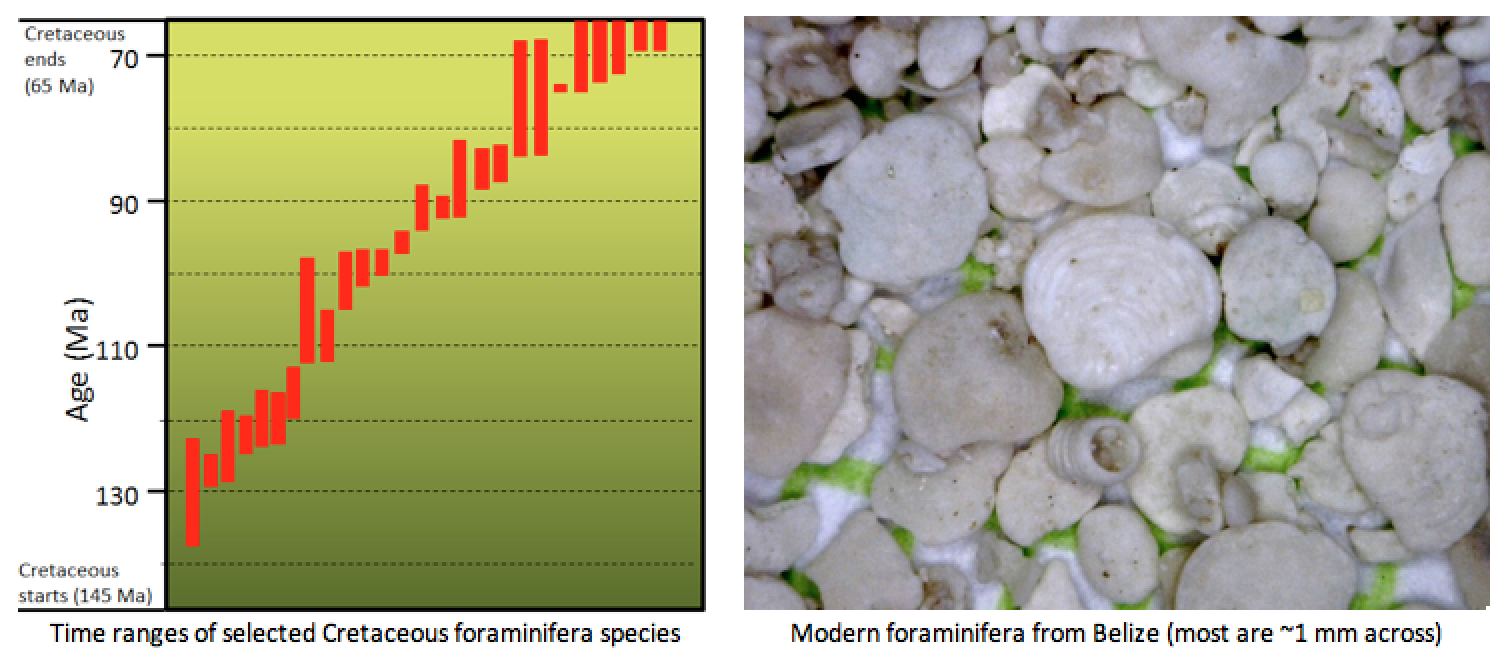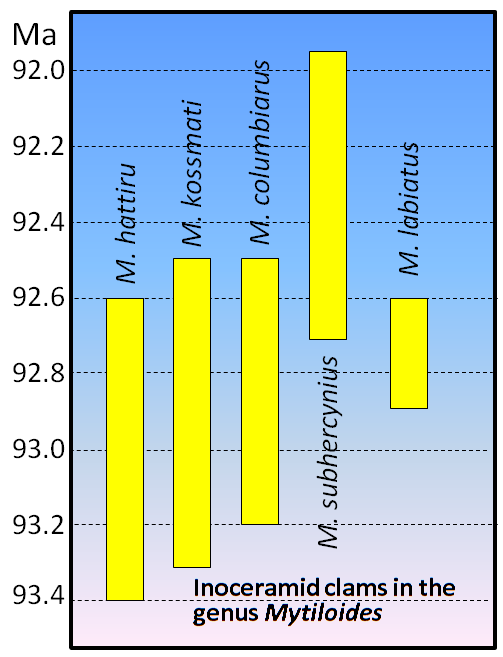How Can Fossil And Rock Data Determine When An Organism Lived Answer Key
Chapter 8 Measuring Geological Time
viii.3 Dating Rocks Using Fossils
Geologists become a broad range of information from fossils. They assistance u.s.a. to empathise development and life in full general; they provide critical information for understanding depositional environments and changes in Earth'south climate; and, of course, they tin exist used to date rocks.
Although the recognition of fossils goes back hundreds of years, the systematic cataloguing and consignment of relative ages to different organisms from the distant past — paleontology — but dates back to the primeval part of the 19th century. The oldest undisputed fossils are from rocks dated effectually three.five Ga, and although fossils this former are typically poorly preserved and are non useful for dating rocks, they can even so provide of import information about conditions at the time. The oldest well-understood fossils are from rocks dating dorsum to around 600 Ma, and the sedimentary record from that time forward is rich in fossil remains that provide a detailed record of the history of life. However, every bit anyone who has gone hunting for fossils knows, that does not hateful that all sedimentary rocks take visible fossils or that they are easy to find. Fossils alone cannot provide us with numerical ages of rocks, but over the past century geologists take acquired plenty isotopic dates from rocks associated with fossil-begetting rocks (such every bit igneous dykes cutting through sedimentary layers) to exist able to put specific time limits on most fossils.
A very selective history of life on Earth over the by 600 million years is provided in Figure viii.ten. The major groups of organisms that we are familiar with evolved between the late Proterozoic and the Cambrian (~600 Ma to ~520 Ma). Plants, which evolved in the oceans every bit green algae, came onto state during the Ordovician (~450 Ma). Insects, which evolved from marine arthropods, came onto country during the Devonian (400 Ma), and amphibians (i.e., vertebrates) came onto land about l 1000000 years later. By the late Carboniferous, trees had evolved from before plants, and reptiles had evolved from amphibians. By the mid-Triassic, dinosaurs and mammals had evolved from very different branches of the reptiles; birds evolved from dinosaurs during the Jurassic. Flowering plants evolved in the late Jurassic or early on Cretaceous. The earliest primates evolved from other mammals in the early Paleogene, and the genus Homo evolved during the belatedly Neogene (~2.viii Ma).
![Figure 8.10 A summary of life on Earth during the late Proterozoic and the Phanerozoic. The top row shows geological eras, and the lower row shows the periods. [SE]](https://opentextbc.ca/geology/wp-content/uploads/sites/110/2016/07/Proterozoic-and-the-Phanerozoic.png)
If we understand the sequence of evolution on Earth, we tin can utilize knowledge to determining the relative ages of rocks. This is William Smith's principle of faunal succession, although of course it doesn't just utilise to "brute" (animals); it can also apply to fossils of plants and those of simple organisms.
The Phanerozoic has seen five major extinctions, equally indicated in Figure 8.x. The about significant of these was at the terminate of the Permian, which saw the extinction of over eighty% of all species and over 90% of all marine species. Most well-known types of organisms were decimated past this event, but only a few became completely extinct, including trilobites. The second most meaning extinction was at the Cretaceous-Paleogene boundary (M-Pg, a.yard.a. the K-T extinction). At that time, about 75% of marine species disappeared. Again, a few well-known types of organisms disappeared altogether, including dinosaurs (just not birds) and the pterosaurs. Other types were badly decimated but survived, and then flourished in the Paleogene. The K-Pg extinction is thought to take been acquired by the touch of a big extraterrestrial torso (10 km to fifteen km across), but it is generally agreed that the other four Phanerozoic extinctions had other causes, although their verbal nature is not clearly understood.
As already stated, it is no coincidence that the major extinctions all coincide with boundaries of geological periods and even eras. Paleontologists have placed near of the divisions of the geological time scale at points in the fossil tape where in that location are major changes in the type of organisms observed.
If we can identify a fossil to the species level, or at least to the genus level, and we know the fourth dimension menstruation when the organism lived, nosotros can assign a range of time to the rock. That range might exist several one thousand thousand years because some organisms survived for a very long fourth dimension. If the rock we are studying has several types of fossils in information technology, and we tin assign time ranges to those fossils, we might exist able to narrow the time range for the age of the stone considerably. An instance of this is given in Figure eight.11.
![Figure 8.11 The application of bracketing to constrain the age of a rock based on several fossils. In this diagram, the coloured bar represents the time range during which each of the four species (A – D) existed on Earth. Although each species lived for several million years, we can narrow down the likely age of the rock to just 0.7 Ma during which all four species co-existed. [SE]](https://opentextbc.ca/geology/wp-content/uploads/sites/110/2016/07/age-of-a-rock.png)
Some organisms survived for a very long time, and are not particularly useful for dating rocks. Sharks, for example, accept been around for over 400 million years, and the great white shark has survived for 16 million years, then far. Organisms that lived for relatively curt time periods are specially useful for dating rocks, peculiarly if they were distributed over a broad geographic area then tin be used to compare rocks from unlike regions. These are known as index fossils. At that place is no specific limit on how short the time bridge has to be to qualify every bit an index fossil. Some lived for millions of years, and others for much less than a million years.
Some well-studied groups of organisms authorize as biozone fossils considering, although the genera and families lived over a long fourth dimension, each species lived for a relatively short time and can be easily distinguished from others on the basis of specific features. For case, ammonites take a distinctive feature known equally the suture line — where the internal beat out layers that separate the private chambers (septae) meet the outer beat out wall, as shown in Figure viii.12. These suture lines are sufficiently variable to place species that can exist used to estimate the relative or absolute ages of the rocks in which they are found.
![Figure 8.12 The septum of an ammonite (white part, left), and the suture lines where the septae meet the outer shell (right). [SE]](https://opentextbc.ca/geology/wp-content/uploads/sites/110/2016/07/septum-of-an-ammonite.png)
Foraminifera (small, carbonate-shelled marine organisms that originated during the Triassic and are still around today) are also useful biozone fossils. As shown in Figure 8.13, numerous different foraminifera lived during the Cretaceous. Some lasted for over ten million years, but others for less than ane meg years. If the foraminifera in a rock can be identified to the species level, nosotros can get a skillful idea of its age.

Do 8.2 Dating Rocks Using Index Fossils
 This diagram shows the historic period ranges for some late Cretaceous inoceramid clams in the genus Mytiloides. Using the bracketing method described above, determine the possible age range of the rock that these five organisms were establish in.
This diagram shows the historic period ranges for some late Cretaceous inoceramid clams in the genus Mytiloides. Using the bracketing method described above, determine the possible age range of the rock that these five organisms were establish in.
How would that change if M. subhercynius was not present in these rocks?
[SE from data at: http://world wide web.fuhrmann-hilbrecht.de/Heinz/geology/InoIntro/InoIntro.html]
How Can Fossil And Rock Data Determine When An Organism Lived Answer Key,
Source: https://opentextbc.ca/geology/chapter/8-3-dating-rocks-using-fossils/
Posted by: nancemaland.blogspot.com


0 Response to "How Can Fossil And Rock Data Determine When An Organism Lived Answer Key"
Post a Comment